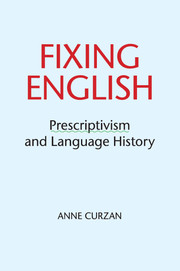Book contents
- Frontmatter
- Dedication
- Contents
- List of figures
- Acknowledgements
- Introduction: does prescriptivism fail?
- 1 Prescriptivism’s umbrella: standards, style, restoration, and political intervention
- 2 Prescriptivism’s lessons: scope and “the history of English”
- 3 Checking grammar and grammar checkers
- 4 Dictionaries and the idea of “real words”
- 5 Nonsexist language reform and its effects
- 6 Reappropriation and challenges to institutionalized prescriptivism
- 7 Finding shared ground: public conversations about prescriptivism
- References
- Index
1 - Prescriptivism’s umbrella: standards, style, restoration, and political intervention
Published online by Cambridge University Press: 05 July 2014
- Frontmatter
- Dedication
- Contents
- List of figures
- Acknowledgements
- Introduction: does prescriptivism fail?
- 1 Prescriptivism’s umbrella: standards, style, restoration, and political intervention
- 2 Prescriptivism’s lessons: scope and “the history of English”
- 3 Checking grammar and grammar checkers
- 4 Dictionaries and the idea of “real words”
- 5 Nonsexist language reform and its effects
- 6 Reappropriation and challenges to institutionalized prescriptivism
- 7 Finding shared ground: public conversations about prescriptivism
- References
- Index
Summary
In linguistics, prescriptivism often serves as a foil: the linguistic “bad guy,” so to speak, or the “threatening Other,” to quote Deborah Cameron (1995, 5). In a frequent scholarly move (which I myself have made in other publications), prescriptivism is contrasted with descriptivism, typically as a way to distinguish the goals of linguistic inquiry from the goals of most usage guides. The assumption often is that readers will be more familiar with the approach of usage guides, thinking of this approach as “grammar” or “the study of grammar”; the contrast, therefore, can open up for readers a different way of studying grammar or language more generally. And the message is, not just different, but better.
The typically sharp dichotomy between descriptivism and prescriptivism helps not only to put distance between the academic discipline of linguistics and the more familiar prescriptive pronouncements about usage based more on opinion than empirical research, but it also assigns more value to the academic discipline. It promotes the examination of language in terms of cognition and biology, not just culture. The now canonical prescriptive–descriptive binary in linguistics can be traced back at least to Otto Jespersen, who wrote in Essentials of English Grammar (1933, 19): “Of greater value, however, than this prescriptive grammar is a purely descriptive grammar.” Descriptivism is the “good guy” in the study of language. As a result, prescriptivism has rarely received an extended definition in its own right, the challenge I take up in this chapter. I am attempting a descriptive account of prescriptivism, given its importance as a sociolinguistic phenomenon.
- Type
- Chapter
- Information
- Fixing EnglishPrescriptivism and Language History, pp. 12 - 40Publisher: Cambridge University PressPrint publication year: 2014

